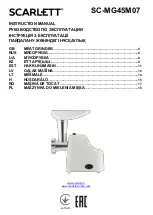
with the work surface. Do not use a damaged Kwik-
Lock nut.
NOTE
The Kwik-Lock nut can be used instead of the clamping
nut. No tools are then required for changing cutting discs.
NOTE
The Kwik-Lock nut cannot be used with cup wheels,
brushes, rubber backing pads, tuck pointing discs (spe-
cial discs used for joint repair) or with diamond cup
wheels.
6.5.1 Fitting grinding / cutting discs using the
Kwik-Lock clamping nut
5
NOTE
The arrow on the upper surface of the nut must be within
the index marks. If the arrow is not within the index marks
when the Kwik-Lock nut is tightened it will be impossible
to release the nut by hand. In this case, use the pin
wrench to release the Kwik-Lock nut (do not use a pipe
wrench!).
1. Disconnect the supply cord plug from the power
outlet.
2. Clean the clamping flange and Kwik-Lock nut.
3.
CAUTION
The clamping flange is equipped with
an O-ring.
If this O-ring is missing, the clamping
flange must be replaced.
Fit the clamping flange onto the drive spindle.
4. Fit the diamond disc, cutting disc or grinding disc.
5. Screw the Kwik-Lock nut onto the spindle until it
contacts the disc (the side with the lettering should
be visible after the nut is screwed on).
6.
CAUTION Do not press the spindle lockbutton
before the drive spindle has stopped rotating.
Press the spindle lockbutton and hold it in this
position.
7. Turn the grinding disc firmly by hand in a clock-
wise direction until the Kwick-Lock nut is tightened
securely and then release the spindle lockbutton.
6.5.2 Removing grinding / cutting discs secured
with the Kwik-Lock nut
1. Disconnect the supply cord plug from the power
outlet.
2. Press the spindle lockbutton and hold it in this
position.
3. Release the Kwik-Lock nut by turning the knurled
ring in a counter-clockwise direction. (Use the pin
wrench to release the Kwik‐Lock nut if very tight. Do
not use a pipe wrench.)
7 Operation
NOTE
Adjust the position of the guard to suit the requirements
of the work being done.
DANGER
Wear ear protectors.
Exposure to noise can cause hear-
ing loss.
CAUTION
The closed side of the guard must always face the
operator.
WARNING
Test new cutting or grinding discs by allowing them
to run at maximum speed in a protected area for at
least 30 seconds.
WARNING
Do not use the power tool if it starts with a jolt.
This
may be an indication that the electronic control unit is
defective. Have the tool repaired at an authorized Hilti
service center right away.
WARNING
Slits cut in loadbearing walls of buildings or other struc-
tures may influence the statics of the structure, especially
when steel reinforcing bars or load-bearing components
are cut through.
Consult the structural engineer, ar-
chitect, or person in charge of the building project
before beginning the work.
WARNING
The electric supply voltage must comply with the in-
formation given on the type identification plate on the
power tool. 230 V power tools may also be connected
to a 220 V supply.
WARNING
Always use the side handle with the power tool.
CAUTION
Use clamps or a vice to hold the workpiece securely.
WARNING
Cutting or grinding may cause splintering of the material.
Wear eye protection.
CAUTION
Breathing protection must be worn if the power tool
is used without a dust removal system for work that
creates dust.
WARNING
Avoid touching rotating parts. Switch the power tool
on only after bringing it into position at the workpiece.
Touching rotating parts, especially rotating insert tools,
may lead to injury.
en
26
DCG 230-D / DAG 230-D, Art. Nr.71747/A2, 05.03.2013
Printed: 08.07.2013 | Doc-Nr: PUB / 5069494 / 000 / 01
















































